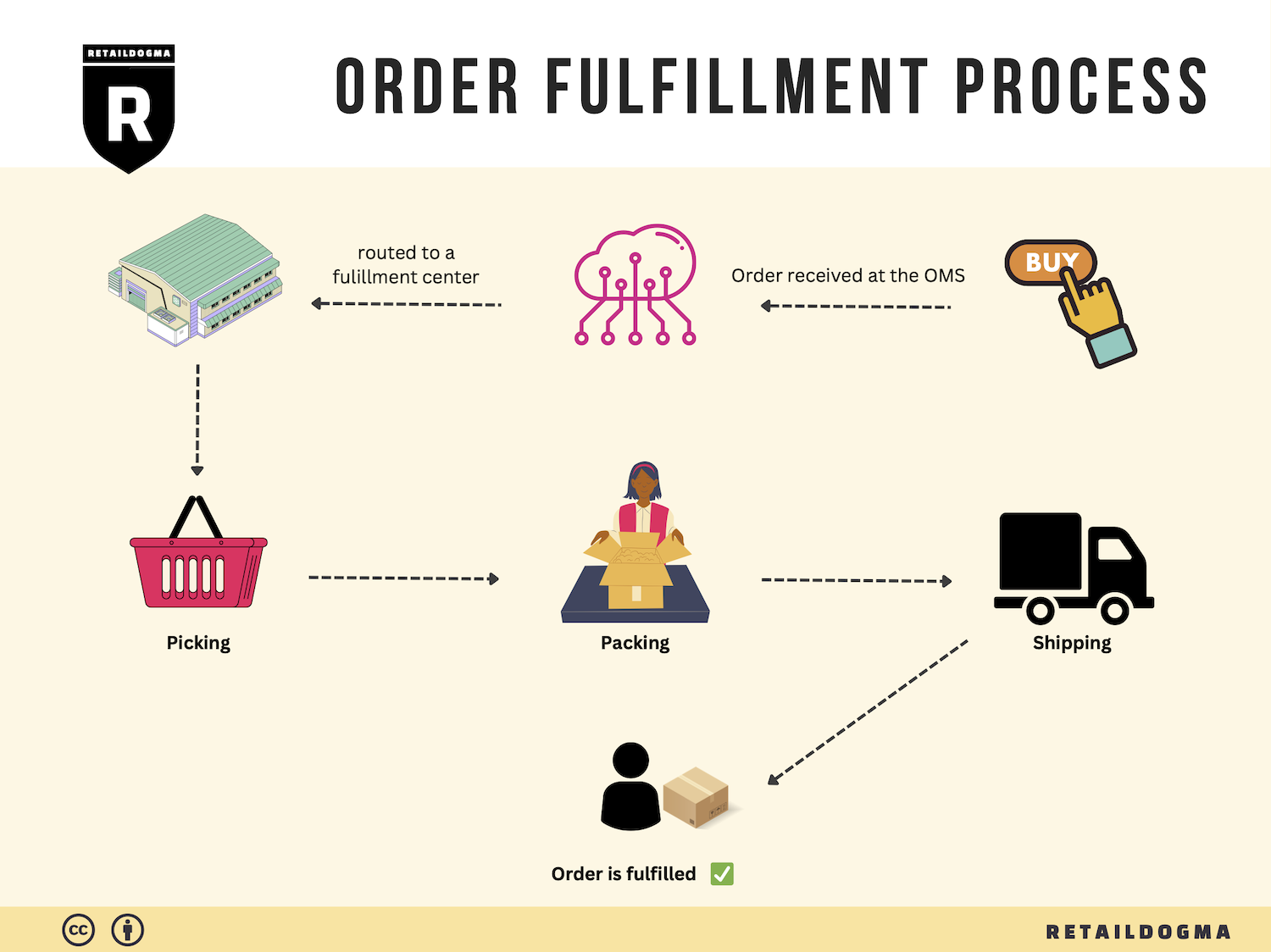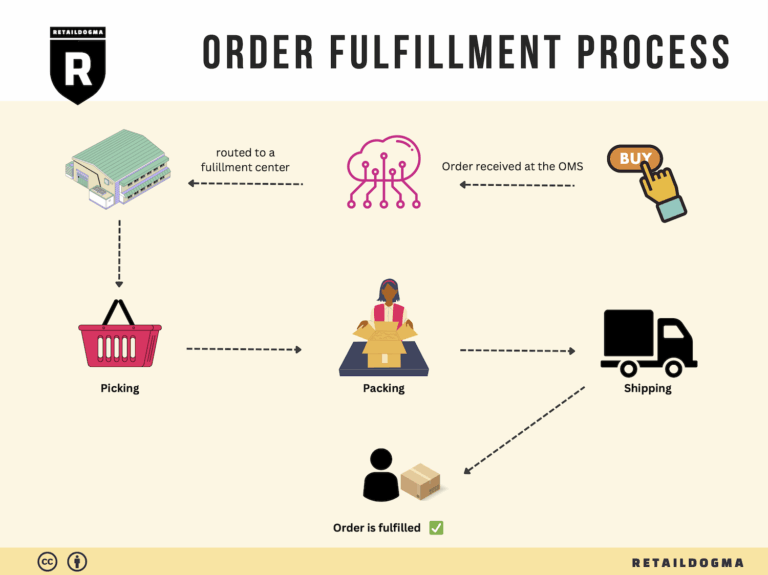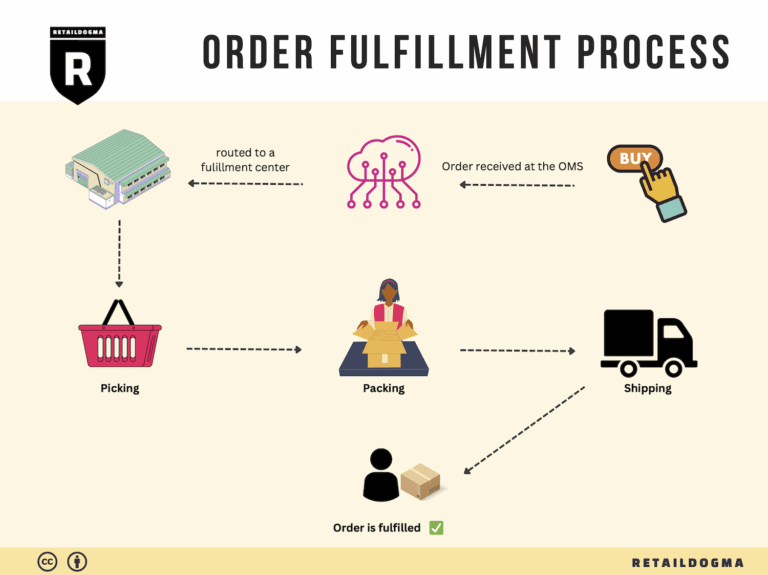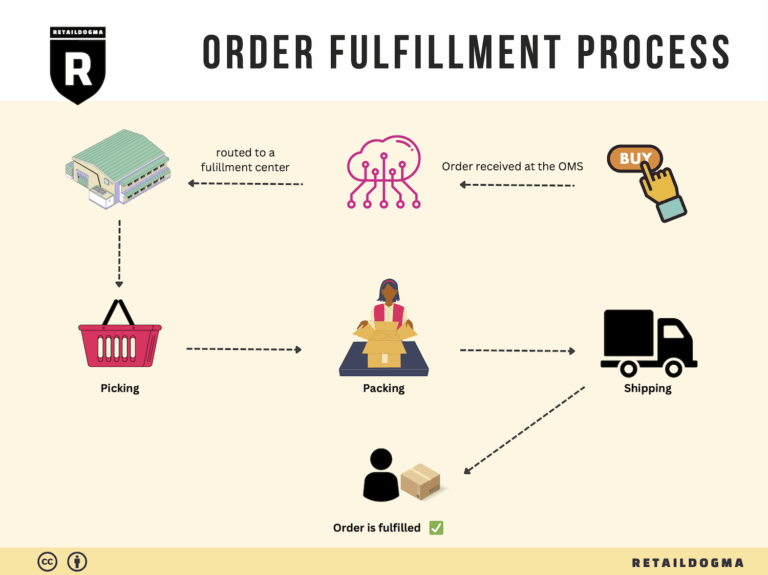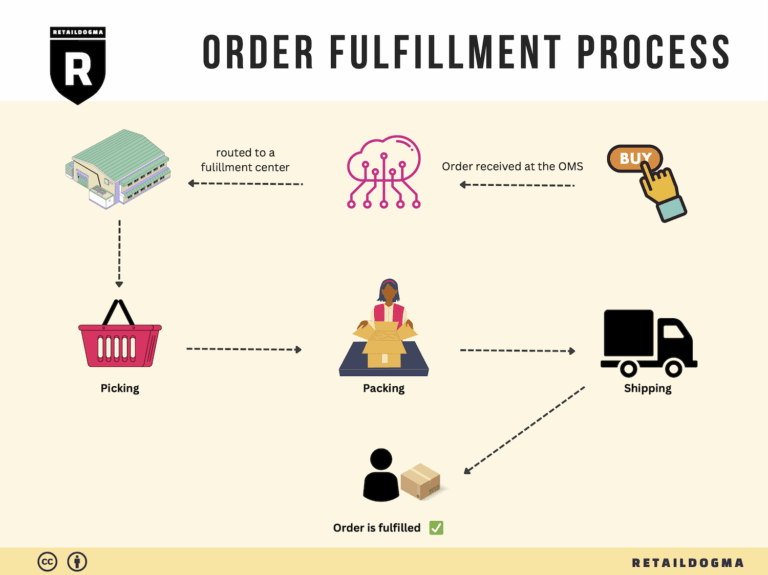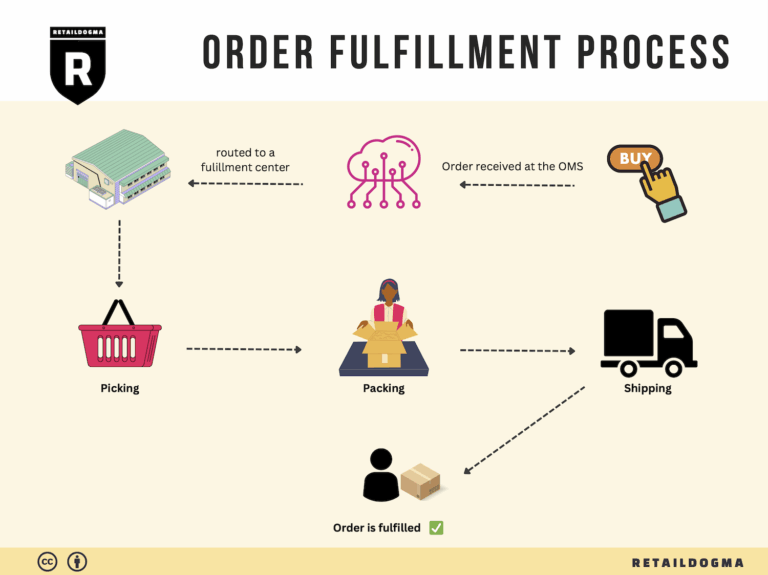Ecommerce Fulfillment Services: The Ultimate Guide (2025)
What is E-commerce Fulfillment? An Introduction for Growing Businesses
Understanding E-commerce Fulfillment: A Critical Component for Growth
As an e-commerce business owner, you may find yourself overwhelmed with the complexities of packing and shipping orders. The excitement of making sales can quickly turn into a logistical nightmare when faced with the challenges of fulfilling those orders efficiently. This is a common pain point for growing online businesses, as the fulfillment process—getting a product into the hands of a customer—can be time-consuming and resource-intensive.
E-commerce fulfillment encompasses a range of activities designed to ensure that products are delivered accurately and on time. This process includes receiving inventory, storing it, picking the right items for each order, packing them securely, and finally shipping them out to customers. The efficiency of your fulfillment operations can significantly impact customer satisfaction, repeat purchases, and ultimately, your bottom line.
In this guide, we will explore various fulfillment models that can help you scale your operations effectively. You’ll learn about traditional third-party logistics (3PL) providers and Amazon’s Fulfillment by Amazon (FBA) service, both of which offer unique advantages for different business needs. Understanding these options is crucial for making informed decisions that align with your growth strategy.
We will also delve into the core services offered by fulfillment partners. These services include inventory management, order processing, shipping, and returns handling. Knowing what to expect from a fulfillment partner can help you assess whether they can meet your business’s specific requirements.
Additionally, we will provide insights on how to choose the right fulfillment partner. Factors such as location, technology capabilities, customer service, and pricing will be discussed to help you evaluate potential partners effectively.
Pricing is another critical element of e-commerce fulfillment. We will break down the typical costs associated with different fulfillment models, enabling you to budget accordingly and choose a solution that offers both value and efficiency.
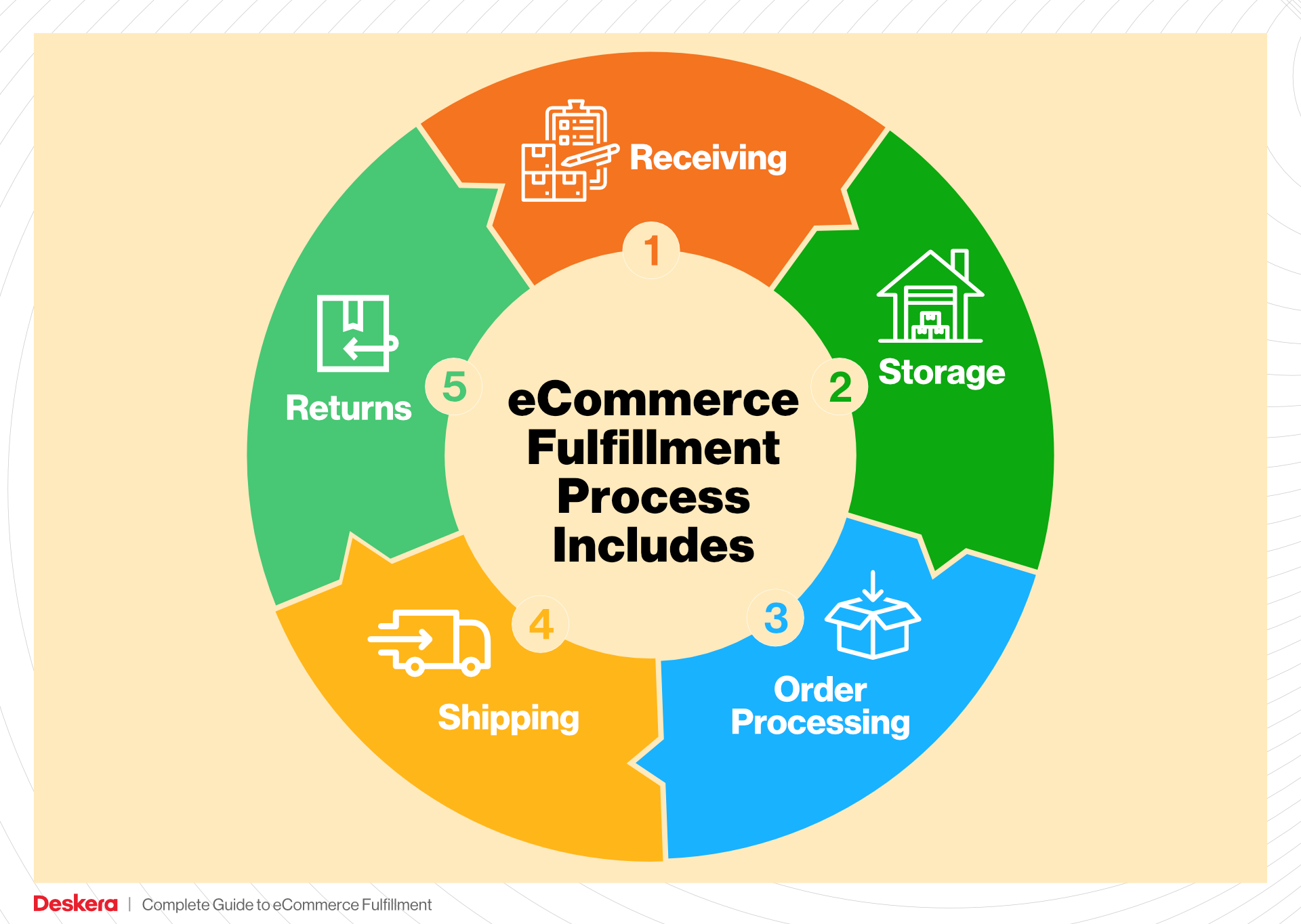
The ultimate goal of this guide is to empower you, as a business owner or operations manager, to make smart, informed decisions regarding your logistics. By understanding the intricacies of e-commerce fulfillment, you can streamline your operations, enhance customer satisfaction, and position your business for sustainable growth.
What You’ll Learn In This Guide
- What is E-commerce Fulfillment? An Introduction for Growing Businesses
- The Order Fulfillment Process: From ‘Buy’ Button to Customer’s Door
- Comparing Fulfillment Models: In-House vs. 3PL vs. Dropshipping
- A Deep Dive into Amazon FBA: Pros, Cons, and Who It’s For
- Core Services Offered by Fulfillment Centers
- How to Choose a Fulfillment Partner: A 6-Point Checklist
- Understanding Fulfillment Pricing: A Breakdown of Common Fees
- Frequently Asked Questions (FAQs) about Fulfillment
- Conclusion: Is Outsourcing Fulfillment the Right Move for Your Business?
- Important Disclaimer
The Order Fulfillment Process: From ‘Buy’ Button to Customer’s Door
1. Receiving Inventory
The order fulfillment process begins with receiving inventory at the fulfillment center. This critical first step involves accepting products from suppliers or other warehouses, where they are checked for quality and accuracy against purchase orders.
During this stage, each item is assigned a Stock Keeping Unit (SKU), which is a unique identifier that helps in tracking inventory levels and managing stock efficiently. Proper receiving procedures are essential to ensure that the right products are accounted for and to minimize discrepancies later in the process. The quality of receiving can significantly affect the entire fulfillment operation; inaccuracies can lead to stockouts, increased return rates, and customer dissatisfaction.
2. Warehouse Storage
Once the inventory is received, it is stored within the fulfillment center until orders are placed. The organization of this storage is crucial for operational efficiency. Fulfillment centers often utilize sophisticated warehouse management systems (WMS) that track the location of each item using barcodes and RFID technology.
Items can be stored in various configurations, such as zone storage or random storage, depending on the fulfillment strategy. Effective warehouse storage practices ensure that items are easily accessible, which can significantly reduce the time taken during the picking process. An organized storage system not only enhances picking speed but also optimizes space utilization, leading to cost efficiencies in managing the facility.
3. Order Picking
When a customer places an order, the fulfillment center receives a notification and begins the picking process. This involves retrieving the items from storage based on a generated pick list, which outlines the products needed for the order.
The picking process can be manual or automated. Automated systems often involve robots bringing storage pods to workers, who then pick items directly from these pods. The efficiency of the picking process is vital; the faster and more accurately items are picked, the quicker orders can be fulfilled. Errors in picking can lead to incorrect shipments, resulting in customer dissatisfaction and increased return logistics. Thus, leveraging technology to enhance picking accuracy is a best practice for scaling businesses.
4. Order Packing
After items are picked, they move to the packing stage. Here, the picked products are carefully packed into boxes to ensure they arrive at the customer’s door in perfect condition. This process often involves scanning items to verify accuracy against the order.
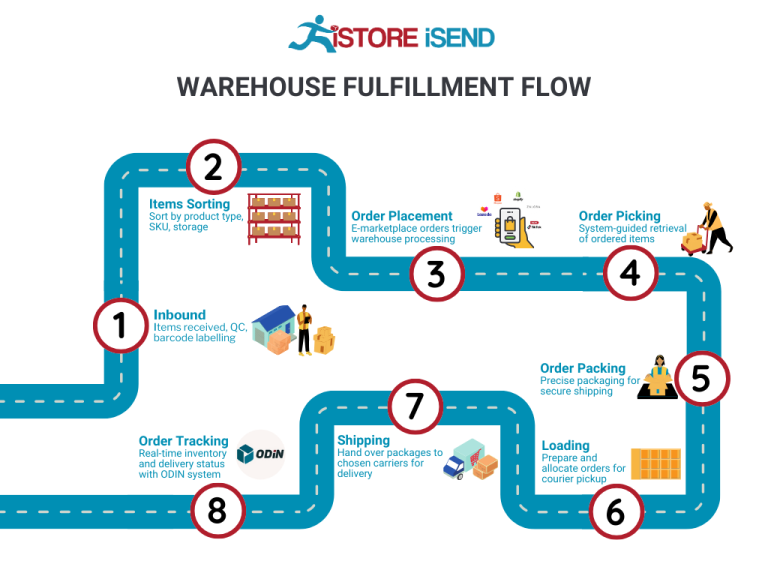
During packing, it’s essential to consider packaging materials and dimensions. Many fulfillment centers use systems that recommend the optimal box size, minimizing waste and reducing shipping costs. This practice aligns with sustainability goals and enhances customer satisfaction by ensuring that packages are not excessively large or small. Effective packing is critical; it protects products during transit and helps maintain a positive brand image.
5. Shipping & Delivery
The final step in the order fulfillment process is shipping the packed orders to customers. Once the packages are packed, they are weighed and labeled using automated systems that apply shipping labels quickly and efficiently. This step ensures that packages are routed correctly based on their destination and shipping method.
Fulfillment centers often employ sophisticated logistics strategies to optimize delivery times. For example, they may utilize different shipping carriers based on speed requirements and cost efficiency. Amazon, for instance, leverages a diverse fleet that includes planes, trucks, and even drones to expedite deliveries. Fast and reliable shipping is crucial for maintaining customer satisfaction and loyalty, particularly for businesses aiming to scale in a competitive market.
In conclusion, mastering the order fulfillment process from receiving inventory to shipping and delivery is essential for e-commerce businesses looking to scale effectively. Each step plays a significant role in ensuring that orders are processed accurately and efficiently, ultimately impacting customer satisfaction and business growth.
Comparing Fulfillment Models: In-House vs. 3PL vs. Dropshipping
Fulfillment Model Comparison
| Model | Who Handles Inventory | Best For (Business Stage) | Key Advantage | Key Disadvantage |
|---|---|---|---|---|
| In-House Fulfillment | Business itself | Established businesses | Full control over inventory and operations | High overhead costs and resource commitment |
| Third-Party Logistics (3PL) | Third-party provider | Growing businesses | Scalable and flexible logistics solutions | Less control over inventory and fulfillment speed |
| Dropshipping | Supplier | Startups and small businesses | Low upfront investment and risk | Lower profit margins and reliance on suppliers |
In-House Fulfillment
In-house fulfillment involves managing the entire logistics process within your own facilities. This model is often adopted by established businesses that have the infrastructure and resources to handle their inventory, order processing, and shipping. The primary advantage of in-house fulfillment is the level of control it offers. Businesses can manage their inventory directly, ensuring that they maintain quality standards and can quickly respond to customer needs. Additionally, they can implement tailored processes that align closely with their brand identity.
However, this model comes with significant disadvantages. High overhead costs are associated with maintaining a warehouse, hiring staff, and investing in technology to manage inventory and shipping. Moreover, as demand fluctuates, businesses may find it challenging to scale operations efficiently without incurring additional costs. The resource commitment required for in-house fulfillment can also detract from focusing on core business functions such as marketing and product development.
Third-Party Logistics (3PL)
Third-party logistics (3PL) involves outsourcing fulfillment operations to a specialized provider. This model is particularly beneficial for growing businesses that require scalable solutions without the burden of managing logistics themselves. 3PL providers offer a range of services, including warehousing, order processing, and shipping, allowing businesses to leverage their expertise and technology to streamline operations.
The key advantage of using a 3PL provider is flexibility. As your business grows, a 3PL can easily adjust to changes in demand, whether that means increasing storage capacity or optimizing shipping routes. Furthermore, partnering with a 3PL can enhance your delivery capabilities, as these providers often have established relationships with carriers and can offer competitive shipping rates.
However, there are downsides to consider. Businesses that rely on 3PL providers may experience a lack of control over their inventory and fulfillment processes. This can lead to issues with order accuracy and fulfillment speed, which can negatively impact customer satisfaction. Additionally, while 3PL services can be cost-effective, they may also introduce variable costs that complicate financial planning.
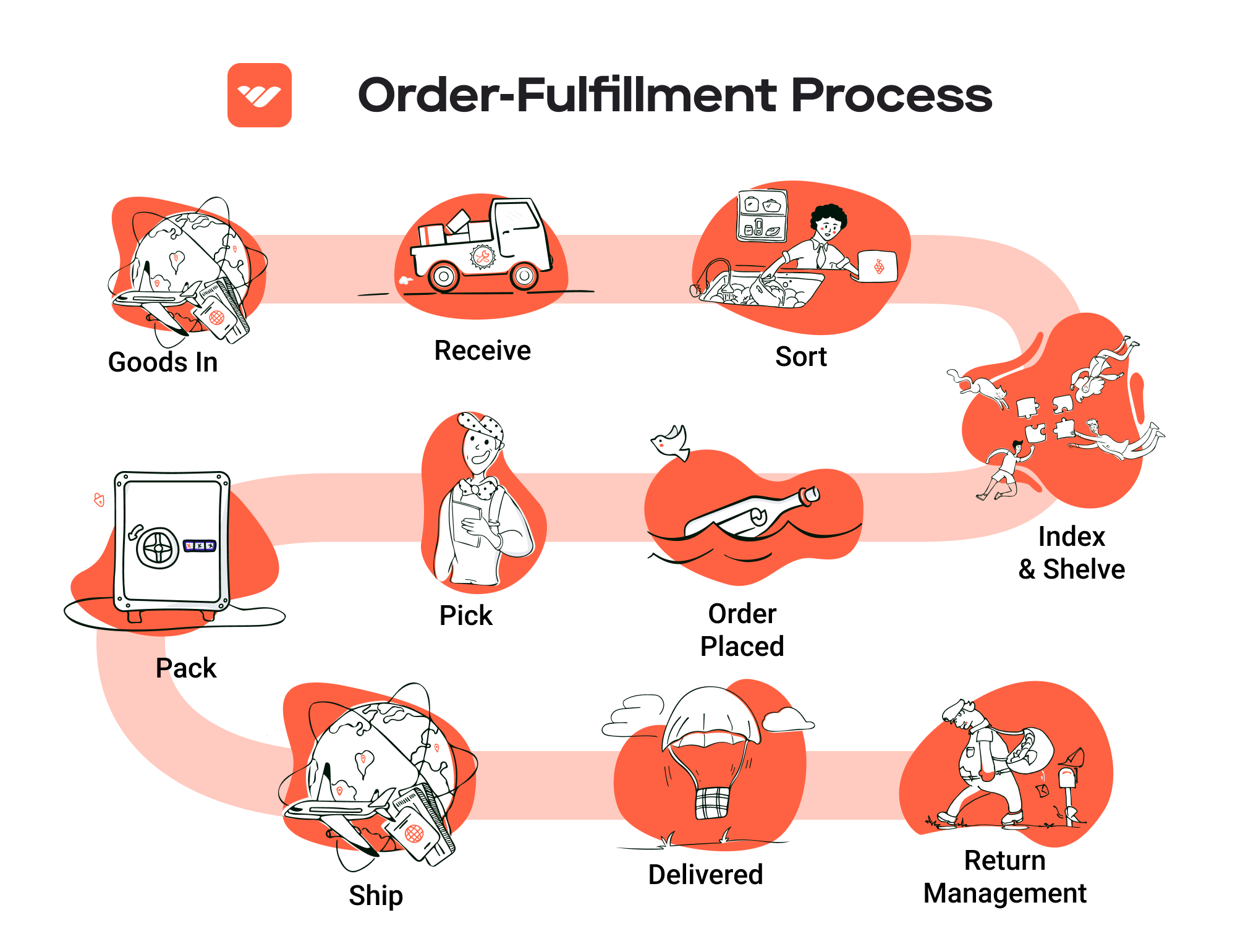
Dropshipping
Dropshipping is a fulfillment model where the retailer does not hold inventory but instead relies on suppliers to ship products directly to customers. This model is ideal for startups and small businesses looking to minimize upfront investment and financial risk. By utilizing dropshipping, entrepreneurs can focus on marketing and sales without the complexities of inventory management.
The primary advantage of dropshipping is the low barrier to entry. Retailers can offer a wide range of products without the need to invest in inventory upfront. This flexibility allows businesses to test various products and markets with minimal risk. Additionally, dropshipping can facilitate rapid scaling, as orders can be processed without the need for warehousing space.
However, dropshipping comes with its own set of challenges. Profit margins can be lower compared to other fulfillment models, as retailers typically pay suppliers a wholesale price that leaves little room for markup. Furthermore, reliance on suppliers means that businesses have less control over product quality, shipping times, and inventory levels. Any delays or issues on the supplier’s end can directly affect customer satisfaction and the retailer’s reputation.
Conclusion
When choosing a fulfillment model, it’s essential for e-commerce business owners and operations managers to consider their specific needs, resources, and growth plans. In-house fulfillment offers control but comes with high costs and resource demands, while 3PL provides scalability and flexibility at the expense of some control. Dropshipping is an excellent entry point for new businesses, although it may yield lower profit margins and depend heavily on supplier reliability. Understanding these nuances will empower businesses to make informed decisions about their logistics strategies, ultimately enhancing their ability to scale effectively.
A Deep Dive into Amazon FBA: Pros, Cons, and Who It’s For
Understanding Fulfillment by Amazon (FBA)
Fulfillment by Amazon (FBA) is a service provided by Amazon that allows sellers to store their products in Amazon’s fulfillment centers. Amazon then takes care of storage, packaging, and shipping of the products to customers. This service also includes customer service and returns management, providing sellers with a comprehensive solution to manage their order fulfillment.
How FBA Works
-
Inventory Shipment: Sellers send their products to Amazon’s fulfillment centers. This can be done in bulk, and sellers can choose to send their entire inventory or just a portion, depending on their sales strategy.
-
Storage: Once the products arrive at the fulfillment center, they are stored in designated locations within the warehouse. Amazon uses advanced inventory management systems to track the products and ensure they are easily accessible.
-
Order Processing: When a customer places an order for a product that is fulfilled by Amazon, the order is automatically processed through Amazon’s system. The fulfillment center retrieves the product, picks it from storage, and prepares it for shipping.
-
Packing and Shipping: The picked items are then packed using Amazon’s optimized packing process, which ensures that the products are well-protected during transit. Amazon handles all shipping logistics, utilizing its extensive delivery network to ensure timely delivery.
-
Customer Service: Amazon manages customer service for FBA orders, handling inquiries and returns, which frees up sellers to focus on other aspects of their business.
-
Multi-Channel Fulfillment: Sellers can also use FBA to fulfill orders from other sales channels, such as their own websites or other marketplaces, further streamlining their operations.
Pros of Fulfillment by Amazon (FBA)
Prime Eligibility
One of the most significant advantages of using FBA is that products become eligible for Amazon Prime. This means they can reach a large base of Prime members who are often willing to pay a premium for faster shipping. Prime eligibility can significantly boost sales and visibility on the platform.
Customer Trust
Amazon is synonymous with customer service and reliability. By using FBA, sellers can leverage Amazon’s reputation, which can enhance customer trust in their products. This is particularly beneficial for new sellers who may not have an established brand presence.
Multi-Channel Fulfillment
FBA allows sellers to fulfill orders from various channels. This means that whether a customer buys a product on Amazon, the seller’s website, or another marketplace, Amazon can handle the logistics. This flexibility can help businesses grow by streamlining their fulfillment processes across different sales platforms.
Scalability
FBA provides a scalable solution for growing businesses. As sales increase, sellers can easily send more inventory to Amazon without the need to invest in their own warehousing and logistics infrastructure. This allows businesses to focus on scaling their operations rather than managing logistics.
Advanced Logistics
Amazon’s sophisticated logistics and delivery network enable sellers to offer fast and reliable shipping options. This efficiency can lead to higher customer satisfaction and repeat purchases.
Cons of Fulfillment by Amazon (FBA)
High Fees
While FBA offers many benefits, it comes at a cost. Sellers must pay for storage fees, fulfillment fees, and other miscellaneous costs. These fees can add up, especially for sellers with low-margin products or those that do not sell quickly.
Strict Inventory Rules
Amazon has stringent inventory management policies. Sellers must adhere to strict guidelines regarding how products are packaged and labeled. Failure to comply can result in additional fees or penalties, which can be particularly challenging for smaller businesses.
Commingling Risks
FBA products may be commingled with similar items from other sellers. This means that when a customer orders a product, they may receive an item that does not belong to the seller. This can lead to issues with quality control and customer dissatisfaction if the received product does not meet expectations.
Loss of Control
When using FBA, sellers relinquish some control over their inventory and customer interactions. This can be a concern for brands that prioritize customer service and brand experience, as they may feel disconnected from their customers.
Potential for Inventory Shortages
During peak seasons, such as holidays, sellers may face challenges in maintaining inventory levels. Amazon has limits on how much inventory can be stored in their fulfillment centers, which can lead to stockouts and lost sales opportunities.
Who is FBA Best For?
Fulfillment by Amazon is ideally suited for businesses that:
-
Have a High Sales Volume: Sellers with a steady flow of orders can benefit from FBA’s efficiencies and economies of scale.
-
Sell Consumer Goods: Products that have a broad appeal and can attract Prime members are likely to perform well with FBA.
-
Desire to Focus on Growth: Businesses looking to scale quickly can leverage Amazon’s infrastructure to handle fulfillment without the overhead costs of managing their own logistics.
-
Want to Enhance Visibility: Sellers who wish to increase their product visibility and sales velocity on Amazon can greatly benefit from the advantages of FBA.
-
Can Manage Costs: Sellers who understand their margins and can absorb the costs associated with FBA will find it a worthwhile investment.
In conclusion, Fulfillment by Amazon provides a powerful tool for e-commerce businesses looking to streamline their operations and scale their sales. However, it is crucial for sellers to weigh the pros and cons carefully to determine if it aligns with their business model and growth strategy.
Core Services Offered by Fulfillment Centers
Inventory Management & Warehousing
Inventory management and warehousing are foundational services provided by fulfillment centers, crucial for e-commerce businesses seeking to optimize their supply chain. This service involves the systematic tracking and storage of products in a secure facility designed to facilitate order fulfillment.
What It Is: Fulfillment centers receive inventory from suppliers, categorize it, and store it in designated areas within the warehouse. Advanced inventory management systems utilize technology such as barcode scanning and RFID tracking to monitor stock levels, location, and movement within the facility.
Benefits: Efficient inventory management ensures that e-commerce businesses maintain optimal stock levels, reducing the risk of stockouts or overstocking. Accurate tracking minimizes human error, thereby improving order accuracy and fulfillment speed. Furthermore, with real-time visibility into inventory levels, businesses can make informed decisions about reordering and product launches, ultimately enhancing customer satisfaction through reliable product availability.
Pick and Pack Services
Pick and pack services are integral to the order fulfillment process, directly impacting how quickly and accurately orders reach customers.
What It Is: This service involves selecting products from the warehouse (picking) and preparing them for shipment (packing). Once an order is placed, the fulfillment center’s system generates a picking list that guides warehouse staff or automated systems to retrieve the correct items. After picking, items are packed into boxes, ensuring they are secure for transit.
Benefits: The pick and pack process is designed for efficiency, often leveraging automation to speed up order processing. By outsourcing this task to a fulfillment center, e-commerce businesses can focus on core operations like marketing and customer service. Moreover, professional packing minimizes damage during shipping, reducing return rates and improving customer satisfaction. Quick and accurate fulfillment can also enhance a brand’s reputation, fostering customer loyalty and repeat business.
Kitting and Assembly
Kitting and assembly services are increasingly valuable for e-commerce businesses that offer products that need to be bundled or assembled before shipping.
What It Is: Kitting involves grouping various individual items into a single package or kit, while assembly refers to putting together components to create a finished product. Fulfillment centers can handle these tasks, preparing products in advance so they are ready for customers upon order.
Benefits: By utilizing kitting and assembly services, businesses can streamline their operations and offer customized products without the need for extensive in-house labor. This service allows for the creation of promotional bundles or gift sets, which can boost sales and enhance customer satisfaction. Additionally, outsourcing these tasks can free up valuable warehouse space and labor resources, allowing e-commerce businesses to focus on growth and innovation rather than routine assembly tasks.
Returns Management (Reverse Logistics)
Returns management, often referred to as reverse logistics, is a critical service provided by fulfillment centers, especially for e-commerce businesses with high return rates.
What It Is: This service encompasses the process of handling returned products, from receiving them back at the fulfillment center to processing refunds or exchanges. Fulfillment centers manage the inspection, restocking, and disposition of returned items, ensuring that the process is efficient and customer-friendly.
Benefits: An effective returns management system can significantly enhance customer experience, as it simplifies the return process for shoppers. By providing clear return policies and quick processing times, businesses can reduce customer frustration and improve retention. Furthermore, efficient handling of returns allows businesses to quickly restock sellable items, minimizing losses associated with returns. This can also provide valuable data on customer preferences and product performance, informing future inventory and product development strategies.
By leveraging these core services offered by fulfillment centers, e-commerce businesses can enhance their operational efficiency, improve customer satisfaction, and ultimately drive sales growth. These services allow businesses to scale effectively, ensuring they can meet customer demand while maintaining control over their logistics operations.
How to Choose a Fulfillment Partner: A 6-Point Checklist
Location & Warehouse Network
Importance:
The geographic location of your fulfillment partner’s warehouses significantly impacts shipping times and costs. A partner with a strategically located network of warehouses can facilitate faster delivery to your customers, ultimately enhancing customer satisfaction and reducing shipping expenses.
Questions to Ask:
– Where are your fulfillment centers located, and how do they align with my target market?
– Do you have multiple warehouses that can cover different regions effectively?
– How do you handle shipping logistics for orders that require cross-country delivery?
Technology & Integrations
Importance:
In today’s fast-paced e-commerce environment, technology plays a crucial role in ensuring efficiency and accuracy. A fulfillment partner with advanced technology can streamline operations, provide real-time inventory updates, and integrate seamlessly with your existing e-commerce platforms.
Questions to Ask:
– What fulfillment management software do you use, and how does it integrate with my e-commerce platform?
– Can you provide real-time tracking for inventory and shipments?
– How do you ensure data security, especially regarding customer information?
Specializations (e.g., Cold Storage, Oversized Items)
Importance:
Different businesses have unique needs when it comes to inventory. If your products require special handling—such as cold storage for perishables or space for oversized items—it’s essential to choose a partner that specializes in those areas.
Questions to Ask:
– Do you have specialized facilities for my type of products (e.g., cold storage, fragile items)?
– What measures do you take to ensure the quality and safety of specialized items during storage and shipping?
– Can you accommodate seasonal fluctuations in inventory or demand for specialized products?
Scalability & Capacity
Importance:
As your business grows, your fulfillment needs will evolve. A good fulfillment partner should be able to scale operations to meet increasing demand without compromising service quality. Understanding their capacity and flexibility is crucial for long-term planning.
Questions to Ask:
– What is your current capacity, and how do you handle peak seasons or sudden spikes in demand?
– Can you easily scale operations (both up and down) based on my business needs?
– What contingency plans do you have in place for unexpected surges in order volume?
Pricing and Contracts
Importance:
Understanding the pricing structure and contract terms of a potential fulfillment partner is vital to ensuring it aligns with your budget and financial goals. Transparent pricing prevents unexpected costs and helps you make informed decisions.
Questions to Ask:
– What is your pricing model (e.g., per order, storage fees, shipping costs)?
– Are there any hidden fees I should be aware of (e.g., for returns, packaging materials)?
– What are the terms of your contract, and is there flexibility for renegotiation as my business evolves?
Customer Support & Reviews
Importance:
Effective customer support can make or break your experience with a fulfillment partner. In case of issues with orders or shipping, having reliable support can save you time and protect your brand reputation. Additionally, reviews and testimonials can provide insights into the partner’s reliability and service quality.
Questions to Ask:
– What customer support channels do you offer (e.g., phone, email, chat)?
– What are your response times for customer inquiries and issues?
– Can you provide references or case studies from other businesses similar to mine?
Conclusion
Choosing the right fulfillment partner is a critical step in scaling your e-commerce business. By using this checklist, you can ensure that you evaluate potential partners thoroughly, taking into account essential factors such as location, technology, specialization, scalability, pricing, and customer support. Making an informed choice will not only streamline your operations but also enhance customer satisfaction and drive growth in the long run.
Understanding Fulfillment Pricing: A Breakdown of Common Fees
Initial Setup Fees
Initial setup fees are often the first costs incurred when engaging a fulfillment service. These fees can include account creation, integration with your e-commerce platform, and initial onboarding support. The purpose of these fees is to cover the administrative and technical resources required to set up your account and ensure that your products are correctly listed in the fulfillment system.
Typically, initial setup fees are calculated as a one-time charge and can vary significantly depending on the complexity of your needs. For instance, if your business requires custom software integrations or specialized training for your team, the setup fees may be higher. On average, businesses can expect to pay anywhere from $50 to several thousand dollars, depending on the service provider and the services included in the setup.
Receiving Fees
Receiving fees are charged when your inventory arrives at the fulfillment center. These fees cover the costs associated with unloading, inspecting, and storing your products. The receiving process includes checking for damages, verifying quantities, and entering items into the inventory management system.
Receiving fees are typically calculated per pallet or per unit, and they can vary based on the size and type of products being received. For example, a fulfillment center may charge a higher rate for oversized items or special handling requirements. Generally, businesses can expect to pay between $10 to $30 per pallet, while smaller items may incur a lower fee of around $0.50 to $1.00 per unit.
Storage Fees (per pallet/bin)
Storage fees are charged for keeping your inventory in the fulfillment center. These fees are crucial for managing the space your products occupy, as they directly correlate with the storage capacity used. Fulfillment centers usually charge storage fees on a monthly basis, and the rates are calculated based on the volume of space your products take up.
Most fulfillment centers charge storage fees either per pallet or per bin, with costs typically ranging from $10 to $50 per pallet per month. Smaller items might incur bin-based fees, which could be around $5 to $20 per bin. Additionally, some centers offer tiered pricing based on the amount of inventory stored, providing discounts for larger volumes. It’s essential to monitor your inventory levels closely to avoid unnecessary storage costs, especially for slow-moving items.
Pick & Pack Fees (per item/order)
Pick and pack fees are charged for the labor involved in picking items from storage and packing them for shipment. This fee structure typically includes two components: the picking fee, which covers the cost of retrieving the items, and the packing fee, which covers the packaging materials and labor to prepare the items for shipping.
These fees are generally calculated on a per-item or per-order basis. For instance, a fulfillment center might charge $0.50 to $3.00 per item for picking and an additional $1.00 to $5.00 for packing, depending on the complexity of the packing requirements. Orders with multiple items may incur a reduced rate per item, as the fulfillment center can optimize the picking process. Understanding your product mix and order patterns can help you estimate these costs accurately.
Shipping Fees
Shipping fees are perhaps the most variable of all fulfillment costs. These fees cover the transportation of your products from the fulfillment center to your customers. Shipping fees depend on several factors, including the shipping method chosen (standard, expedited, etc.), the weight and dimensions of the package, and the destination.
Fulfillment centers often have negotiated rates with shipping carriers, which can help reduce costs for businesses. Shipping fees can be calculated either as flat rates or based on weight and distance. For example, standard shipping might cost between $5 and $15 for smaller packages, while larger, heavier items may incur fees of $20 or more. It’s crucial to work with your fulfillment partner to understand how these fees are structured and explore options for bulk shipping discounts or optimized shipping methods.
Tips for Getting an Accurate Quote
To ensure you receive an accurate quote for fulfillment services, consider the following tips:
-
Provide Detailed Information: Be specific about your product types, dimensions, and expected order volumes. The more detailed your information, the more precise the quote.
-
Ask About All Fees: Inquire about all potential fees, including those not typically listed upfront, such as additional handling fees for special requests or seasonal price changes.
-
Evaluate Different Providers: Compare quotes from multiple fulfillment centers to get a sense of the market rates and services offered. Look for transparency in their pricing models.
-
Consider Volume Discounts: If your business anticipates growth, ask about volume discounts or tiered pricing structures that can save you money as your order volume increases.
-
Review Contract Terms: Before signing any agreements, carefully review the contract terms to understand any hidden fees or long-term commitments that could affect your costs.
By understanding these common fees and how they are calculated, you can better manage your fulfillment expenses and optimize your e-commerce operations.
Frequently Asked Questions (FAQs) about Fulfillment
1. What is the DET1 Amazon Fulfillment Center?
The DET1 Amazon Fulfillment Center, located in Livonia, Michigan, is a state-of-the-art facility designed for processing and fulfilling orders placed on Amazon. It serves as a storage and distribution hub where inventory is received, picked, packed, and shipped to customers efficiently.
2. How does the fulfillment process work at the DET1 center?
The fulfillment process at the DET1 center involves several key steps: inventory receiving, storage, order processing, picking, packing, and shipping. Once an order is placed, the center retrieves the items, packages them appropriately, and ships them out using optimized logistics to ensure timely delivery.
3. What technology does the DET1 Fulfillment Center use?
The DET1 Fulfillment Center utilizes advanced technologies such as automated sorting systems, robotics for item retrieval, and sophisticated software for inventory management. These technologies help streamline operations, enhance accuracy, and improve overall efficiency in order fulfillment.
4. What’s the difference between a warehouse and a fulfillment center?
A warehouse primarily serves as a storage space for goods, focusing on inventory management and bulk storage. In contrast, a fulfillment center is designed for the complete order fulfillment process, including receiving orders, picking, packing, and shipping products directly to customers. Fulfillment centers often include additional services like customer support and returns management.
5. What is Fulfillment by Amazon (FBA)?
Fulfillment by Amazon (FBA) is a service that allows sellers to store their products in Amazon’s fulfillment centers, like DET1. Amazon takes care of storage, packaging, shipping, and customer service, allowing sellers to focus on growing their businesses while benefiting from Amazon’s logistics network.
6. How much do fulfillment services cost?
Fulfillment services costs can vary based on several factors, including the size and weight of the products, storage duration, and order volume. Typically, costs may include storage fees, fulfillment fees (per item shipped), and additional charges for special handling or packaging. It’s advisable to consult Amazon’s pricing guidelines or a third-party logistics provider for detailed estimates.
7. How can businesses leverage the DET1 Fulfillment Center for growth?
Businesses can leverage the DET1 Fulfillment Center by utilizing Amazon’s Fulfillment by Amazon (FBA) program, which allows them to tap into Amazon’s vast logistics network. This can lead to faster shipping times, reduced operational costs, and improved customer satisfaction, ultimately contributing to business growth.
8. Where is the DET1 Fulfillment Center located?
The DET1 Fulfillment Center is situated in Livonia, Michigan. Its strategic location enables efficient distribution to a wide range of customers in the Midwest and beyond, facilitating quicker delivery times.
9. What types of products can be fulfilled at the DET1 center?
The DET1 Fulfillment Center is capable of handling a wide variety of products, including electronics, household items, clothing, and more. However, there are restrictions on certain categories, such as hazardous materials or perishable goods. Sellers should review Amazon’s guidelines to ensure compliance.
10. What are the benefits of using the DET1 Fulfillment Center?
Using the DET1 Fulfillment Center offers several benefits, including access to Amazon’s extensive logistics network, improved delivery speed, and enhanced customer service capabilities. Additionally, businesses can scale their operations without the overhead of managing warehousing and shipping logistics themselves, allowing them to focus on sales and marketing strategies.
Conclusion: Is Outsourcing Fulfillment the Right Move for Your Business?
Evaluating the Benefits of Outsourcing Fulfillment
Outsourcing fulfillment can be a transformative decision for e-commerce businesses aiming to scale efficiently. One of the primary benefits is the significant time savings. By leveraging a fulfillment service, you can delegate the complexities of inventory management, order processing, and shipping logistics to experts. This allows you to focus on strategic growth initiatives, marketing, and enhancing customer experiences—areas that drive sales and long-term success.
Scalability is another critical advantage. As your business grows, so do your fulfillment needs. Fulfillment partners, such as Amazon’s DET1 center, offer the infrastructure to handle increased order volumes seamlessly. They have the capacity to scale operations without the headaches of expanding your own warehouse space or hiring additional staff. This flexibility is crucial in today’s fast-paced e-commerce environment, where consumer expectations for speed and reliability are higher than ever.
Moreover, partnering with a fulfillment service brings expertise that can optimize your logistics operations. With advanced technology and established processes, these centers can enhance accuracy and efficiency in order fulfillment, helping to reduce errors and improve customer satisfaction. By outsourcing, you gain access to sophisticated systems that can track inventory in real-time, ensuring that your products are available when customers want them.
However, the choice of fulfillment partner is paramount. A misaligned partnership can hinder rather than help your growth. Conduct thorough research, assess your specific needs, and choose a fulfillment service that aligns with your business goals and values.
Take Action
As a next step, consider auditing your current shipping and fulfillment processes. Evaluate your order volume, customer feedback, and operational efficiency. This analysis will help you determine if outsourcing fulfillment is the right move for your business. If you find gaps or inefficiencies, it may be time to explore fulfillment partners that can drive your growth forward.
Important Disclaimer
⚠️ Important Disclaimer
The information in this guide is for educational purposes. Fulfillment services, pricing, and platform features change frequently. Always conduct your own due diligence and consult with providers directly before making business decisions.
